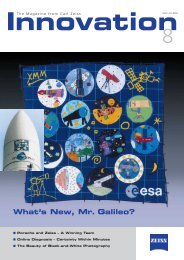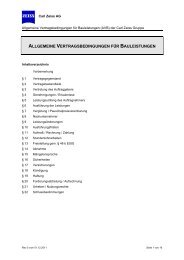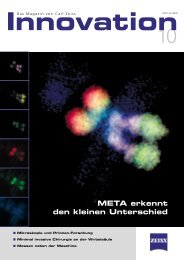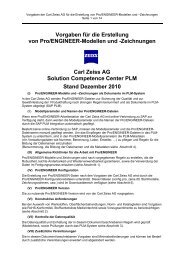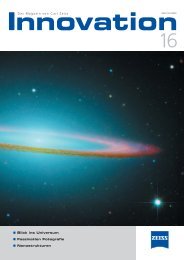Download PDF - Carl Zeiss
Download PDF - Carl Zeiss
Download PDF - Carl Zeiss
You also want an ePaper? Increase the reach of your titles
YUMPU automatically turns print PDFs into web optimized ePapers that Google loves.
The brightest object in the class of<br />
ultra-luminous x-ray sources (ULX) in<br />
the local group, i.e. the cluster of<br />
galaxies closest to the Milky Way, is<br />
situated in the Holmberg II dwarf<br />
galaxy approx. 10 million light-years<br />
away (Fig. 1). In addition to investigations<br />
in the x-ray range, the search<br />
for emissions in the visual range of<br />
the spectrum is of key interest. It<br />
is hoped that spectral analysis of<br />
this radiation may allow scientists to<br />
make a conclusion regarding the<br />
nature of accretion and the mass of<br />
the object.<br />
During the PMAS Science Verification<br />
Run at the Calar Alto 3.5 m telescope,<br />
Ho II-X1 was observed which<br />
indeed demonstrated the extremely<br />
faint signature of a high-excitation<br />
gas nebula at the site of the x-ray<br />
source (Fig. 2). Earlier observations<br />
with an elongated slit spectrograph<br />
had been unsuccessful as the uncertain<br />
positional information from the<br />
x-ray data made a “coincidental” hit<br />
in directing the telescope very unlikely.<br />
The 8x8 arc second field of view<br />
of the PMAS made it possible to<br />
direct the telescope without having<br />
to make presumptions regarding the<br />
suspected coordinates so that the<br />
Innovation 16, <strong>Carl</strong> <strong>Zeiss</strong> AG, 2005<br />
high excitation helium II emission line<br />
at 486.6 nm, as an indicator, appeared<br />
just on the edge of the field<br />
of view. The analysis of the dimensions<br />
of the object and its kinematic<br />
properties together with the x-ray<br />
observation data indeed showed<br />
that Ho II-X1 is highly likely to be<br />
an intermediate-size black hole. The<br />
results obtained by the international<br />
research group of Lehmann (Max<br />
Planck Institute of Extraterrestrial<br />
Physics, Garching, Germany) and the<br />
PMAS team (AIP) were published as<br />
the cover story in the March 2005<br />
issue of the renowned technical<br />
journal, Astronomy & Astrophysics.<br />
Fig. 3a: Top: Monochromatic images<br />
at various important wavelengths<br />
extracted from the data cube<br />
of a PMAS recording. Bottom: Velocity<br />
field (false-color chart) and width<br />
at half intensity of the emission lines<br />
of hydrogen at 486.1 nm (H-beta)<br />
and oxygen at 500.7 nm ([O III]). A<br />
red circle at the lower left marks the<br />
point at which the high excitation<br />
helium emission line was detected.<br />
Fig. 3b: The spectrum generated<br />
by addition within the red circle (Fig.<br />
3a). The weak emission line indicated<br />
by He II (singly-ionized helium) shows<br />
f � (1E-15)<br />
5<br />
4<br />
3<br />
2<br />
1<br />
HE II<br />
H-beta<br />
that a compact, extremely hot source<br />
resides in this area. The same line is<br />
not detectable in other regions.<br />
Fig. 3c: Actual observation of a<br />
gravitational lens, in which a lowluminosity<br />
galaxy in the foreground<br />
(faint red spot in the center), rather<br />
than a black hole, splits the light of<br />
a far-away bright quasar behind the<br />
galaxy in the foreground into 4 components<br />
(PMAS observation). Quasars<br />
are enormously bright, active galaxy<br />
cores, in which accretion towards<br />
a super mass-rich black hole gives<br />
rise to luminosity exceeding the total<br />
brightness of the galaxy by far.<br />
[0 III]<br />
[0 III]<br />
Martin Matthias Roth,<br />
Astrophysics Institute Potsdam<br />
http://www.aip.de<br />
0<br />
4600 4800<br />
� (Å)<br />
5000<br />
3a 3b<br />
3c<br />
11




